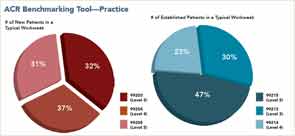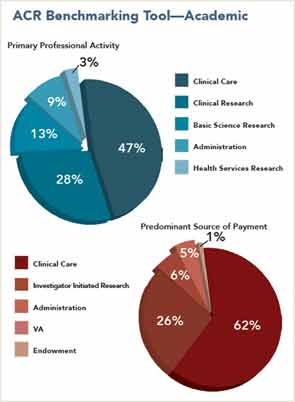Academic
Of the academic rheumatologists who completed the survey (see pie charts at right), 62% reported clinical care as their predominant source of payment, and 26% indicated investigator-initiated research was the primary source of the majority of their income. Of that group, 47% selected clinical care as their primary professional activity, and 41% reported their primary activity as either clinical or basic research.
The discrepancy between sources of income and amount of time spent indicates that funding for research is insufficient to support the time spent in the activity. Only 9% of academic rheumatologists who responded to the survey have received NIH support during their career. The NIH award mechanism that was the most common among respondents is the R01 award, with 21.8% indicating they have received one. This was sobering data for me when I first saw it, but it reflects the crisis in academic rheumatology research.
The New & Improved 2014 Benchmark Tool
Beginning in 2014, the new version of the ACR Benchmark Tool will transition from a rolling survey format to a yearly collection of data. The tool will be open for responses for a three-month period each year. The smaller window to complete the survey will strengthen the integrity and timeliness of data collected. It will also demand timely responses from practices.
The next version of the tool is expected to be available Sept. 1 through Dec. 1, 2014. The ACR will alert members once the tool is open for responses. It will be available online to complete when you find it convenient. You may also complete the survey on site in November at the Annual Meeting at kiosks stationed there. If you choose this option, you will need the data from your practice available to you at the meeting.
Angus Worthing, MD, Arthritis and Rheumatism Associates, Washington, D.C., participated in the first ACR benchmark survey and says he also plans to participate when the new tool opens. “I encourage all my colleagues to make time to complete the survey when it opens in September so the ACR can gather & provide the most up-to-date data nationwide on practicing rheumatologists,” he says.
The link to take the Benchmark Tool and to access results after completing the tool will be available in each ACR member’s My Profile section on the ACR website. Once you have filled out the Benchmark Tool, you will have the ability to see how your enterprise compares in each aspect with others regionally and nationally. The data from other practices will, of course, be de-identified. If you completed the 2012 Benchmark Tool, I’m sure you found that having the ability to view your performance and your practice’s activities compared with others in your region and across the country can be very useful.
The ACR Benchmark Tool is a superb resource to help the ACR collect & analyze data on the rheumatology workforce & identify local & membership-wide trends & performance issues that can be addressed by the ACR & its committees. I hope each ACR member will complete the 2014 Benchmark Tool when it is released in September, so the ACR can better serve the needs of the rheumatology workforce.’
The 2012–2014 Benchmark Tool offered a good opportunity to further beta test the concept of the tool and its elements. But because so few members completed it, it does not yet have the power it should have to help us gauge our performance relative to our peers. ACR’s challenge is to discover what will motivate us to make the time to contribute to this potentially powerful information database.

